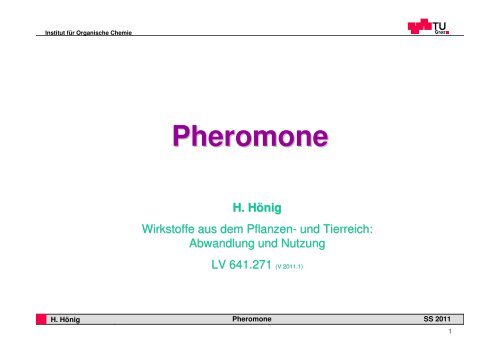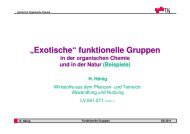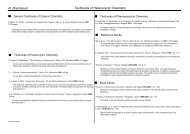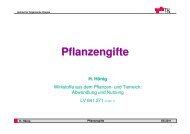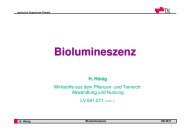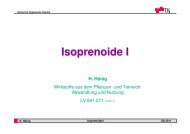Pheromone - Institut für Organische Chemie
Pheromone - Institut für Organische Chemie
Pheromone - Institut für Organische Chemie
Sie wollen auch ein ePaper? Erhöhen Sie die Reichweite Ihrer Titel.
YUMPU macht aus Druck-PDFs automatisch weboptimierte ePaper, die Google liebt.
<strong>Institut</strong> <strong>für</strong> <strong>Organische</strong> <strong>Chemie</strong><br />
<strong>Pheromone</strong><br />
H. Hönig<br />
Wirkstoffe aus dem Pflanzen- Pflanzen und Tierreich:<br />
Abwandlung und Nutzung<br />
LV 641.271 (V 2011.1)<br />
Professor H. Hönig Horst Cerjak, 19.12.2005<br />
<strong>Pheromone</strong> SS 2011<br />
1
<strong>Institut</strong> <strong>für</strong> <strong>Organische</strong> <strong>Chemie</strong><br />
Einteilung<br />
physiologisch<br />
wirksame<br />
Verbindung<br />
intraspezifische<br />
Botenstoffe<br />
Primer<br />
Signalstoffe<br />
Botenstoffe<br />
semiochemicals interspezifische<br />
Botenstoffe<br />
<strong>Pheromone</strong> Allelochemicals<br />
verhaltensauslösendes<br />
Signal<br />
Releaser<br />
vorteilhaft <strong>für</strong><br />
den Sender<br />
Allomone<br />
vorteilhaft <strong>für</strong><br />
den Emfänger<br />
Kairomone<br />
Professor H. Hönig Horst Cerjak, 19.12.2005<br />
<strong>Pheromone</strong> SS 2011<br />
2
<strong>Institut</strong> <strong>für</strong> <strong>Organische</strong> <strong>Chemie</strong><br />
Einleitung<br />
Sind ein phyllogenetisch altes Kommunikationsmittel<br />
kommen in Protozoen, Arthropoden,<br />
aber auch in höheren Tieren wie Fischen, Kriechtieren<br />
und Säugetieren vor<br />
werden auch bei der Gattung Mensch diskutiert.<br />
Vor allem aber sind sie in der Klasse der Insekten<br />
[Hexapoda] weit verbreitet<br />
Professor H. Hönig Horst Cerjak, 19.12.2005<br />
<strong>Pheromone</strong> SS 2011<br />
3
<strong>Institut</strong> <strong>für</strong> <strong>Organische</strong> <strong>Chemie</strong><br />
Arten<br />
Sexuallockstoffe<br />
Sexualpheromone<br />
Aggregationspheromone<br />
Rekrutierungspheromone<br />
Spurpheromone<br />
Territorialmarkierungsstoffe<br />
Alarmpheromone und Wehrsekrete<br />
Königinnensubstanzen<br />
Kastenerkennungsstoffe<br />
Eiablagepheromone, etc.<br />
Professor H. Hönig Horst Cerjak, 19.12.2005<br />
<strong>Pheromone</strong> SS 2011<br />
4
<strong>Institut</strong> <strong>für</strong> <strong>Organische</strong> <strong>Chemie</strong><br />
<strong>Chemie</strong> und Funktion<br />
<strong>Pheromone</strong> sind vielfach biogenetische Abkömmlinge<br />
von Fettsäuren<br />
Sie gehören fast ausschließlich zu den sensorisch<br />
wirkenden Releaserpheromonen, die eine<br />
unmittelbare Verhaltensauslösung im<br />
Empfängerindividuum bewirken<br />
Bis 1995 ca 800 Strukturen bekannt<br />
Professor H. Hönig Horst Cerjak, 19.12.2005<br />
<strong>Pheromone</strong> SS 2011<br />
5
<strong>Institut</strong> <strong>für</strong> <strong>Organische</strong> <strong>Chemie</strong><br />
Schmetterlinge<br />
1959, nach 20 Jahren Arbeit:<br />
A. BUTENANDT klärt die Struktur des Lockstoffs des<br />
weiblichen Seidenspinners Bombyx mori auf und<br />
„verbraucht“ dazu über 500.000 Weibchen<br />
Bombykol<br />
RN 765-17-3<br />
Wahrnehmungsgrenze <strong>für</strong> Männchen:<br />
10 -16 bis 10 -18 g / ml<br />
Professor H. Hönig Horst Cerjak, 19.12.2005<br />
<strong>Pheromone</strong> SS 2011<br />
OH<br />
[ MG: 238,4 -> 2.526 Moleküle / ml !<br />
d.h. alle 0.7 mm ein Molekül! ]<br />
6
<strong>Institut</strong> <strong>für</strong> <strong>Organische</strong> <strong>Chemie</strong><br />
Käfer (I)<br />
Sexualpheromon von Hylotrupes bajulus,<br />
(der gemeine Hausbock)<br />
Professor H. Hönig Horst Cerjak, 19.12.2005<br />
<strong>Pheromone</strong> SS 2011<br />
O<br />
(+)-Verbenon<br />
NSC 36846<br />
(R,R)-(+)-α: RN 18309-32-5<br />
(S.S)-(-)-cis: NSC 6831: RN 1196-01-6<br />
(±): RN 80-57-9<br />
ohne Stereobez.: RN 872992-30-8<br />
7
<strong>Institut</strong> <strong>für</strong> <strong>Organische</strong> <strong>Chemie</strong><br />
Käfer (II)<br />
Sexualpheromon von Pityogenes<br />
chalcographus, (Kupferstecher)<br />
O<br />
5<br />
2<br />
O<br />
H<br />
(-)-trans-Chalcogran<br />
(2S,5R)-trans-(-) : RN 70427-57-5<br />
(2S,5S)-cis-(-): RN 70427-58-6<br />
(2R,5S)-trans: RN 69744-43-0<br />
(2R,5R)-cis: RN 69744-44-1<br />
rel-(2R,5R)-cis-(±): RN 75443-93-5<br />
rel-(2S,5R)-trans-(±): RN 75443-94-6<br />
ohne Stereobez. RN 38401-84-2<br />
Professor H. Hönig Horst Cerjak, 19.12.2005<br />
<strong>Pheromone</strong> SS 2011<br />
8
<strong>Institut</strong> <strong>für</strong> <strong>Organische</strong> <strong>Chemie</strong><br />
Ameisen (I)<br />
Atta texana, Blattschneiderameise<br />
Alarmpheromon:<br />
(S)-(+)-4-Methyl-3-heptanone<br />
(S)-(+): RN 51532-30-0<br />
(R)-(-): RN 51532-31-1<br />
(±): RN 6137-11-7<br />
Professor H. Hönig Horst Cerjak, 19.12.2005<br />
<strong>Pheromone</strong> SS 2011<br />
O<br />
Spurpheromon:<br />
N<br />
H O<br />
Methyl 4-methylpyrrole-2-carboxylate<br />
RN 34402-78-3<br />
O<br />
9
<strong>Institut</strong> <strong>für</strong> <strong>Organische</strong> <strong>Chemie</strong><br />
Ameisen (II)<br />
Spurpheromon von Monomorium pharaonis, (Pharaoameise)<br />
Faranal<br />
RN 65395-77-9<br />
Professor H. Hönig Horst Cerjak, 19.12.2005<br />
<strong>Pheromone</strong> SS 2011<br />
O<br />
10
<strong>Institut</strong> <strong>für</strong> <strong>Organische</strong> <strong>Chemie</strong><br />
Ameisen (III)<br />
Alarmpheromon der<br />
Holzameise<br />
Lasius fuliginosus<br />
Dendrolasin<br />
RN 23262-34-2<br />
kommt auch in der japanischen<br />
Nusseibe (Kaya) Torreya nucifera vor<br />
Professor H. Hönig Horst Cerjak, 19.12.2005<br />
<strong>Pheromone</strong> SS 2011<br />
O<br />
11
<strong>Institut</strong> <strong>für</strong> <strong>Organische</strong> <strong>Chemie</strong><br />
Fliegen<br />
Kontaktpheromon von Musca domestica, der<br />
Hausfliege mit Arrestant-Wirkung auf die Männchen<br />
Muscalur<br />
RN 27519-02-4<br />
Professor H. Hönig Horst Cerjak, 19.12.2005<br />
<strong>Pheromone</strong> SS 2011<br />
12
<strong>Institut</strong> <strong>für</strong> <strong>Organische</strong> <strong>Chemie</strong><br />
Termiten<br />
Spurpheromon von<br />
Nasutitermes sp.,<br />
(-)-Cembren A<br />
Neocembren<br />
RN 31570-39-5<br />
Ningaloo Nat. park,<br />
Westaustralien,<br />
August 2006<br />
Professor H. Hönig Horst Cerjak, 19.12.2005<br />
<strong>Pheromone</strong> SS 2011<br />
13
<strong>Institut</strong> <strong>für</strong> <strong>Organische</strong> <strong>Chemie</strong><br />
Schaben / Wanzen<br />
O<br />
1<br />
H<br />
(Z)-α-Bisabolen-1,2-epoxid<br />
t-(1S,4S,6R)-(-): RN 111536-37-9<br />
c-(1R,4S,6S)-(-): RN 111613-41-3<br />
c-(1S,4R,6R)-(+): RN 121467-35-4<br />
rel-(1R,4R,6S): RN 112574-89-7<br />
rel-(1R,4S,6S): RN 112574-90-0<br />
(1R,4R,6S)-: RN 121467-34-3<br />
RN 366464-55-3:<br />
mixt aus: RN111613-41-3 und RN 111536-37-9<br />
Sexualpheromon<br />
der Wanze<br />
Nezara veridula<br />
O<br />
R=H: 3,11-Dimethyl-2-nonacosanone<br />
Ohne Stereobez.: RN 53623-10-2<br />
(3R,11R): RN 69274-88-0<br />
(3R,11S): RN 69274-89-1<br />
(3S,11R): RN 69274-91-5<br />
(3S,11S): RN 69274-90-4<br />
R=OH: 29-Hydroxy-3,11-dimethyl-2-nonacosanone<br />
ohne Stereobez.: RN 60789-53-9<br />
(3R,11R): RN 79016-06-1<br />
(3R,11S): RN 79016-04-9<br />
(3S,11R): RN 79016-05-0<br />
(3S,11S): RN 79016-03-8<br />
Sexualpheromone der<br />
deutschen Schabe<br />
Blatella germanica<br />
Professor H. Hönig Horst Cerjak, 19.12.2005<br />
<strong>Pheromone</strong> SS 2011<br />
R<br />
14
<strong>Institut</strong> <strong>für</strong> <strong>Organische</strong> <strong>Chemie</strong><br />
Blattläuse<br />
H<br />
O<br />
H<br />
O<br />
(+)-Nepetalacton<br />
RN 21651-53-6<br />
Alarmpheromone der<br />
Platterbsen-Blattlaus<br />
Megoura viciae<br />
Sexualpheromon der<br />
Platterbsen-Blattlaus<br />
Megoura viciae<br />
(+) und (-)- Nepetalacton aber auch:<br />
Katzenlockstoff aus der Katzenminze<br />
1<br />
7<br />
6<br />
5<br />
(1R)-(+)-α-Pinen<br />
(+): RN 7785-70-8<br />
(-): RN 7785-26-4<br />
(±): RN 80-56-8<br />
EINECS 201-291-9<br />
(1R)-(+)-ß-Pinen<br />
(+): RN 19902-08-0<br />
(-): RN 18172-67-3<br />
(±): RN 127-91-3<br />
EINECS 204-872-5<br />
Professor H. Hönig Horst Cerjak, 19.12.2005<br />
<strong>Pheromone</strong> SS 2011<br />
1<br />
6<br />
7<br />
15
<strong>Institut</strong> <strong>für</strong> <strong>Organische</strong> <strong>Chemie</strong><br />
Spinnen<br />
Lardolur<br />
RN 83540-84-5<br />
O<br />
O<br />
O<br />
Aggregationspheromon<br />
der Milbe<br />
Lardoglyphus konoi<br />
O<br />
Die Bolaspinne<br />
Ordgarius magnificus<br />
produziert ein Allomon,<br />
und lockt damit Falter<br />
als Beute an !<br />
9-Tetradecenyl-acetat<br />
(Z): RN 16725-53-4<br />
Professor H. Hönig Horst Cerjak, 19.12.2005<br />
<strong>Pheromone</strong> SS 2011<br />
16
<strong>Institut</strong> <strong>für</strong> <strong>Organische</strong> <strong>Chemie</strong><br />
Algen<br />
(-)-Hormosiren<br />
Beim Fingertang<br />
(Laminariales) und beim<br />
Stacheltang (Desmarestiales)<br />
wirken die Lockstoffe auch<br />
als Release-Faktoren<br />
(d.h. Freisetzung und<br />
Anlockung der männlichen<br />
Spermatozoiden)<br />
Fucoserraten<br />
RN 40087-61-4<br />
Lamoxiren<br />
RN 29837-19-2<br />
Lock-Pheromon<br />
des Blasentangs (Fucales)<br />
Professor H. Hönig Horst Cerjak, 19.12.2005<br />
<strong>Pheromone</strong> SS 2011<br />
O<br />
RN 29837-20-5 (+)-Caudoxiren<br />
[2R-[2α,3β(1S*,5S*)]]-(+): (R,R,S,S): RN 117415-46-0<br />
Desmaresten<br />
RN 83013-90-5<br />
O<br />
H<br />
H<br />
H<br />
[2S-[2α,3β(1S*,5S*)]]: (S,S,R,R): RN 142630-55-5<br />
[2S-[2α,3β(1R*,5R*)]]: (S,S,S,S): RN 142630-54-4<br />
[2α,3β(1S*,5S*)]-(±): rel (S,S,R,R): RN 130607-94-2<br />
[2α,3α(1S*,5S*)]-(±): rel (R,S,S,S): RN 117468-51-6<br />
17
<strong>Institut</strong> <strong>für</strong> <strong>Organische</strong> <strong>Chemie</strong><br />
Säugetiere (I)<br />
<strong>Pheromone</strong> scheinen <strong>für</strong> Säugetiere eher von geringerer<br />
Bedeutung, weil die Sinnesorgane <strong>für</strong> akustische und<br />
visuelle Reize besser entwickelt sind<br />
H<br />
O<br />
H<br />
(5α)-Androst-16-en-3-on<br />
RN 18339-66-7<br />
H<br />
H<br />
Professor H. Hönig Horst Cerjak, 19.12.2005<br />
<strong>Pheromone</strong> SS 2011<br />
HO<br />
(5α)-Androst-16-en-3α-ol<br />
RN 11153-51-1<br />
Beim männlichen Schwein und Mensch<br />
H<br />
H<br />
H<br />
H<br />
18
<strong>Institut</strong> <strong>für</strong> <strong>Organische</strong> <strong>Chemie</strong><br />
Säugetiere (II)<br />
Positronen-Emissions-Tomographie menschlicher Gehirne<br />
nach Einwirkung verschiedener Steroide<br />
[aus I. Savic, Proc.Nat.Acad.Sci, N.Y., 102 (2005) 7356-7361]<br />
Professor H. Hönig Horst Cerjak, 19.12.2005<br />
<strong>Pheromone</strong> SS 2011<br />
19
<strong>Institut</strong> <strong>für</strong> <strong>Organische</strong> <strong>Chemie</strong><br />
Säugetiere (III)<br />
Bei der männlichen Hausmaus (Mus musculus)<br />
S<br />
N<br />
2-sec-Butylthiazoline<br />
(±): RN 56367-27-2<br />
(S)-(+): RN 250359-27-4<br />
(R)-(-): RN 250359-30-9<br />
3,4-Dehydro-exo-brevicomin<br />
(1S,5R,7S)-(1S-exo)-(+): RN 109429-39-2<br />
(1R,5S,7R)-(1R-exo)-(-): RN 109429-32-5<br />
(±)-(1S,5R,7R)-rel-1-endo:RN 93426-67-6<br />
(±)-(1R,5S,7R)-rel-1-exo: RN 62255-25-8<br />
ohne Stereobez.: RN 159912-77-3<br />
Professor H. Hönig Horst Cerjak, 19.12.2005<br />
<strong>Pheromone</strong> SS 2011<br />
O<br />
O<br />
20
<strong>Institut</strong> <strong>für</strong> <strong>Organische</strong> <strong>Chemie</strong><br />
Säugetiere (IV)<br />
Für die männliche Hausmaus (Homo musculus)<br />
Auch Hormone sind Botenstoffe (im eigenen Körper)<br />
Professor H. Hönig Horst Cerjak, 19.12.2005<br />
<strong>Pheromone</strong> SS 2011<br />
21
<strong>Institut</strong> <strong>für</strong> <strong>Organische</strong> <strong>Chemie</strong><br />
<strong>Pheromone</strong> im Film<br />
nach Patrick Süßkinds (geb. 1949) Roman „Das Parfum“ (1985)<br />
Professor H. Hönig Horst Cerjak, 19.12.2005<br />
<strong>Pheromone</strong> SS 2011<br />
22
<strong>Institut</strong> <strong>für</strong> <strong>Organische</strong> <strong>Chemie</strong><br />
„Aus einer Mücke einen Elefanten machen“<br />
„Urinprobe“<br />
http://web.utah.edu/unews/releases/02/sep/elephant.html:<br />
„Sniffing Out Secrets of Elephant Sex“<br />
Biochemistry , Oct 2002 ; aber schon länger bekannt::<br />
Nature (London) 379 (1996) 684<br />
Das Pheromon <strong>für</strong> beide species:<br />
H. J. Bestmann und O. Vostrowsky<br />
Naturwissenschaften, 69 (1982) 457-471<br />
(Z)-7-Dodecenyl-acetat<br />
RN 14959-86-5<br />
Professor H. Hönig Horst Cerjak, 19.12.2005<br />
<strong>Pheromone</strong> SS 2011<br />
O<br />
O<br />
23
<strong>Institut</strong> <strong>für</strong> <strong>Organische</strong> <strong>Chemie</strong><br />
Im flüssigen Medium<br />
Auch lösliche Feststoffe als Signalstoffe:<br />
z.B. im Einzeller Euplotes raikovi<br />
Interessant als Vorstufen von Botenstoffen in Vielzellern<br />
Reduced Euplomones: (3 Disulfid-Brücken)<br />
CAS-Reg.Nr. Name Sequenz<br />
120852-74-6 r10 DLCEQSALQC NEQGCHNFCS PEDKPGCLGM VWNPELCP<br />
118337-10-3 r1 DACEQAAIQC VESACESLCT EGEDRTGCYM YIYSNCPPYV<br />
Professor H. Hönig Horst Cerjak, 19.12.2005<br />
<strong>Pheromone</strong> SS 2011<br />
24
<strong>Institut</strong> <strong>für</strong> <strong>Organische</strong> <strong>Chemie</strong><br />
Aplysia-Attractine<br />
aus der Meeresschnecke Aplysia<br />
Aplysia Reg. Nr. 1 22 54<br />
A. depilans 716831-22-0 NNKCDLEFAS SECQMRYQDC GEASNCTALI EECKTSLQEE CDQASSESSS TTIRPE<br />
A. fasciata 716831-20-8 DQNCDIGNTI TSQCEMQHQN CDDANGCNTI IEECKTSMVE RCQNQEFESA SGSTTLGPQ<br />
A. brasiliana 716831-19-5 DQNCDIGNIT SQCQMQHQNC DDANGCDTII EECKTSNVER CQNQEFESAS GTTLGPQ<br />
A. californica 716831-18-4 DQNCDIGNIT SQCQMQHKNC EDANGCDTII EECKTSMVER CQNQEFESAA GSTTLGPQ<br />
A. 210299-69-7 DQNCDIGNIT SQCQMQHKNC EDANGCDTII EECKTSMVER CQNQEFESAA GSTTLGPQ<br />
Professor H. Hönig Horst Cerjak, 19.12.2005<br />
<strong>Pheromone</strong> SS 2011<br />
25
<strong>Institut</strong> <strong>für</strong> <strong>Organische</strong> <strong>Chemie</strong><br />
<strong>Pheromone</strong> im Pflanzenschutz<br />
<strong>für</strong> das Monitoring<br />
Insektenfallen <strong>für</strong> die Überwachung der Populationsentwicklung<br />
als Verwirrtechnik<br />
Überangebot an synthetischen Weibchenpheromone verwirrt<br />
Männchen, Partnerfindung unterbunden<br />
im Massenfang<br />
zur vollständigen Entfernung eines Befalls<br />
Professor H. Hönig Horst Cerjak, 19.12.2005<br />
<strong>Pheromone</strong> SS 2011<br />
26
<strong>Institut</strong> <strong>für</strong> <strong>Organische</strong> <strong>Chemie</strong><br />
Literaturbeispiele<br />
J. Amberg-Müller<br />
<strong>Pheromone</strong> in kosmetischen Produkten - Die Beeinflussung des anderen Geschlechts<br />
mit körpereigenen menschlichen Duftstoffen (Physiologie und Toxikologie)<br />
Mitt. Lebensm. Hyg. 91 (2000) 597-609<br />
A. Winman:<br />
Do perfume additives termed human pheromones warrant being termed pheromones?<br />
Physiology & Behavior 82 (2004) 697-701<br />
B. M. Pause<br />
Are androgen steroids acting as pheromones in humans?<br />
Physiology & Behavior 82 (2004) 21-29<br />
K. Wüthrich et al.,<br />
NMR structure of the of the Euplotes raikovi pheromone Er-23 and identification of its five<br />
disulfide bonds<br />
J. Mol. Biol. 313 (2001) 923-931<br />
Professor H. Hönig Horst Cerjak, 19.12.2005<br />
<strong>Pheromone</strong> SS 2011<br />
27
<strong>Institut</strong> <strong>für</strong> <strong>Organische</strong> <strong>Chemie</strong><br />
Ende der Einheit<br />
„<strong>Pheromone</strong>“<br />
Professor H. Hönig Horst Cerjak, 19.12.2005<br />
<strong>Pheromone</strong> SS 2011<br />
28


